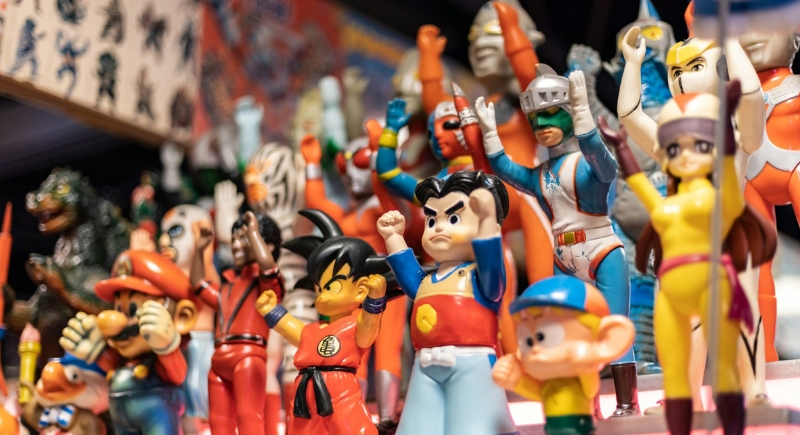When WWF Wrestling Action Figures Ruled the 1980s Toy Scene
In the 1980s, the toy market was a battlefield of fantasy and adventure. Hasbro’s G.I. Joe and Transformers lines earned hundreds of millions of dollars, while Mattel’s He-Man figures dominated holiday wish lists. The formula for success seemed to be a popular animated series paired with a line of toys. However, one company took a different approach, seeing an opportunity not in cartoons but in the larger-than-life spectacle of professional wrestling. That company was LJN, and between 1984 and 1989, it would create a pop culture sensation with its line of WWF wrestling figures.
The Birth of a Sensation (A Happy Accident)

Image via Unsplash/Alex Robertson
When toy manufacturer LJN Toys Ltd. picked up the license to produce figures for the popular WWF Superstars, they were a company in need of a hit.
LJN had just taken a significant financial bath after licensing a series of toys for the 1984 motion picture Dune. The movie was a box office flop, and the toys were a commercial disaster. With the company reeling, they were skeptical about getting back into the high-stakes world of movie and television tie-ins.
Then came Vince McMahon and the WWF. Wrestling was experiencing a national expansion, with its larger-than-life personalities appearing on MTV alongside pop culture icons like Cyndi Lauper and Mr. T. Seeing the explosion in popularity, the toymaker decided to take a gamble and license WWF action figures.
Initially, the plan was to produce figures similar in scale to the popular 3.75-inch G.I. Joe and Star Wars lines. However, the company’s designers created larger, 8-inch prototypes to better showcase the products for buyers. Fascinated by their massive size, the buyers insisted on producing the figures at that scale. LJN agreed, and that one decision would become a defining characteristic of the entire line.
At the same time, the WWF’s primary competitor, the American Wrestling Association (AWA), had its own line of action figures produced by Remco. But the Remco figures were smaller and articulated. LJN’s line was heavy, solid hunks of rubber with almost no points of articulation. This earned them the nickname, “inaction figures,” but also made them virtually indestructible. They were the perfect toys for kids to smash together in a wrestling ring.
Built to Last (The “Inaction” Figures)

Image via Unsplash/Markus Spiske
The LJN WWF line was a masterclass in turning limitations into strengths. The figures’ lack of articulation was a direct result of production challenges. According to former LJN product manager Bill Stanhope, the large size of the figures made it difficult and cost-prohibitive to add metal wires to make them poseable. The amount of material needed was a “big problem,” and so they decided to focus on what they could do best: create incredibly detailed, solid rubber likenesses.
The designers relied on press kits, photos, and 8×10 glossies to sculpt the wrestlers’ appearances, as there was no internet then. This fast-paced, outsourced production often led to fascinating behind-the-scenes issues that are now part of the toys’ lore.
For instance, the body hair on the George “The Animal” Steele figure was originally sculpted but couldn’t be correctly applied to the final toy, so it was left as flesh-colored bumps. These production challenges also led to collectible variants, such as different-colored chains for Junkyard Dog or two different-colored skirts for Miss Elizabeth, often based on whatever materials the factory in China had available.
To compensate for the lack of articulation, LJN created a variety of accessories and alternative figure lines. The iconic Sling ‘Em-Fling ‘Em Wrestling Ring and a separate cage match accessory complemented the figures perfectly.
For kids who wanted more flexibility, the company released a line of more miniature, pliable figures called Bendies, which were closer to the original size the company had intended to make. There were even tiny Thumb Wrestlers for on-the-go grappling and a line of Stretch Wrestlers that mimicked the popular Stretch Armstrong toy.
The Final Bell

Image via Unsplash/Birmingham Museums Trust
LJN continued to produce new waves of figures until 1989, when the company was shut down by its parent company, MCA Universal, due to legal issues unrelated to the toy line. This is a crucial detail for collectors today, as it means the line’s end was not a result of poor sales. The final wave of LJN figures was produced by a Canadian company called Grand Toys, and these “black carded” re-releases of popular figures like Bret “Hitman” Hart and The Ultimate Warrior are now some of the most sought-after and expensive collectibles in the line.
LJN’s departure marked the end of an era, and Hasbro eventually picked up the WWF license in 1990. While subsequent toy lines introduced more articulation and action features, nothing could quite replicate the imposing, solid feel of the original LJN figures.